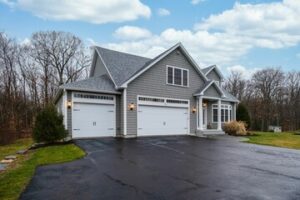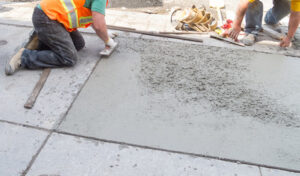Asphalt driveways can be durable and affordable. However, their longevity depends on several factors, including thickness and base quality.

The dark color of asphalt hides oil stains, rust, and other environmental damage, reducing the need for frequent cleaning and maintenance. Concrete, on the other hand, shows stains and needs regular cleaning to maintain its appearance. To learn more, visit https://www.pavementsolutionstx.com/.
Asphalt is a durable material that can last for a long time, especially when it is properly maintained. The lifespan of a driveway depends on the type of weather conditions in your area, the amount of traffic, and if you have heavy vehicles like trucks that may cause damage to the pavement. The pavement must be regularly sealcoated and repaired as soon as you notice any cracks.
Unlike concrete, asphalt is easy to patch and repair, which makes it an economical option for homeowners that are on a tight budget. If your driveway has extensive cracks or is sunken, it will probably need to be resurfaced or replaced. Asphalt driveways require relatively minimal repairs right after they are installed but need regular maintenance to keep them looking their best and working correctly.
The longevity of an asphalt driveway is largely dependent on the climate in your area and the quality of the asphalt mix used in construction. A higher quality mix is more likely to last longer, as will a proper installation with good base materials. Cold weather will deteriorate asphalt faster than hot weather because of the freeze-thaw cycles, and sun exposure can accelerate the oxidation of asphalt binders.
A well-constructed asphalt driveway can last for about 15 to 25 years, which is shorter than a concrete driveway but still a decent lifetime for a residential surface. Concrete, on the other hand, can last for 30 years or more when properly maintained and is an excellent choice for areas with harsh climates.
Asphalt driveways can also be damaged by the weight of heavy vehicles, which causes them to wear down more quickly than light ones. It is also important to have your driveway sealed every couple of years and not use de-icing salts, which can corrode the surface.
The appearance of an asphalt driveway can be marred by tire marks and roller marks, which can leave splotchy patches on the surface. The good news is that these blemishes are cosmetic and don’t affect the durability of the driveway or its ability to resist damage from vehicles. Asphalt also absorbs heat from the sun, which can cause the surface to soften and melt when parked for too long on a warm day. This is why it is recommended to only park your vehicle on the driveway on sunny days or when you’re expecting guests.
Skid-Resistant
Having an asphalt driveway is more than just about convenience. Its skid-resistant properties can help reduce the number of crashes on your property and in the surrounding area. It is also a safer option for those who drive in snowy weather. While concrete can be damaged by rock salt, asphalt is more resistant to these chemicals and can withstand the freeze-thaw cycle of wintertime driving without cracking.
There are several factors that affect the available skid resistance at the tire-pavement interface. These include the slip ratio, vehicle speed, inclination of the tire, and braking action. The latter is one of the most critical factors, and it should be taken into account when assessing friction at the road surface.
The texture of the pavement is another important factor that influences wet skid resistance. Different asphalt mixes add different textures to the pavement, which offer different levels of skid resistance. However, as the pavement ages, its texture deteriorates and its macrotexture changes. In addition, the aggregates become more polished with cumulative traffic loads and lose their ability to resist shear.
Furthermore, the temperature-dependent viscoelastic behavior of rubber in a tire has a significant influence on hysteretic friction, which must be considered in the design and evaluation of asphalt. A recent study suggests that a proper assessment of the available wet skid resistance requires taking into consideration all the critical factors involved.
In order to achieve this, engineers need to develop a more reliable pavement design method. For this, finite element (FE) modelling is a suitable tool that can be used to assess the wet skid resistance of a roadway under various traffic conditions. However, FE models are typically nondeformable and neglect the effect of deformation on pavement structures on friction, which can significantly affect its performance. Therefore, the development of a new FE model that can take the deformability into account will be helpful to assess the performance of pavement under various conditions. In addition, the model should be able to consider the impact of the road geometry and the tire tread pattern on wet skid resistance.
Easy Maintenance
Asphalt is a very hardy material that can withstand pressure from all kinds of vehicles, both small and large. It is also a lot cheaper than concrete, making it a popular choice for homeowners and business owners alike. It is also very easy to maintain and repair. Small repairs can be done with readily available products, and a routine plan of maintenance can keep your driveway in good condition for years to come.
One of the most common problems that can affect asphalt is oil and gas spills. These should be cleaned up as soon as they happen to prevent deterioration of the bitumen underneath. Weeds are another issue that can cause damage to a driveway. They can develop in areas that are low and damp, and they will quickly spread. Regular weeding can keep these from growing and help the asphalt last longer.
Other issues that can affect your asphalt driveway include puddles, surface depressions and cracks. Water pools and puddles can lead to deterioration of the base layer under the asphalt, and they can look unattractive as well. These should be filled with liquid or hot pour rubber cracks filler as soon as they appear to stop further deterioration. Cracks that are not repaired will simply widen with the thawing and freezing cycles of winter, which can also damage the bitumen.
Regularly sweeping and removing snow promptly will keep your asphalt in great shape, and it is a good idea to avoid the use of de-icing chemicals on the surface, as these can also cause harm. It is also a good idea to have your driveway sealed every 3-4 years to protect it against graying from the sunlight, and to prevent any infiltration from rainwater. An experienced builder can advise on the best materials and procedures to ensure your asphalt has a long life cycle. In addition, a proper grade and slope of the driveway is crucial to its longevity, as is ensuring that the soil is raked correctly. This will ensure that there are no isolated low areas where water can puddle and cause damage.
Affordable
If you’re looking to add curb appeal to your property and increase its value without breaking the bank, asphalt is a great option. It’s more affordable than concrete, and it provides a long-lasting, smooth surface to park your car on.
In addition, many professional asphalt paving companies provide installation services that can reduce the overall cost of your driveway. These include the removal of your old driveway and base, as well as any other outdoor services that might be bundled with the installation process. If you are looking to save even more, consider hiring a contractor that uses recycled materials for their asphalt driveways. This will not only help you cut costs but also limit your impact on the environment.
The typical asphalt driveway is made from hot mix asphalt, which typically costs $3 to $6 per square foot. This doesn’t include the labor required to lay and compact the material. The exact price will depend on the size of your driveway, which type of asphalt you choose, and any other services you might require.
Another factor that affects the cost of an asphalt driveway is the condition of the existing base and under-bed. If the driveway was built incorrectly, or if there are large cracks and divots in the surface, these will need to be fixed before laying the new asphalt. This can be a costly endeavor, but it’s essential for ensuring that your driveway lasts.
Homeowners who are concerned about the environmental impact of their asphalt driveways should opt for porous asphalt. This material is designed to drain water more easily and limits the amount of material that ends up in landfills. It’s important to note, however, that the benefits of this type of asphalt are largely cosmetic and may not be as effective as non-porous asphalt.
Finally, homeowners who want to personalize their asphalt driveway can do so by adding color. This is done by mixing pigment into the asphalt mixture before it’s laid. This allows you to create a unique design that adds visual interest to your property. Depending on your preferences, you can choose between a variety of colors, including natural tints of aggregates and eye-catching red and green hues.



